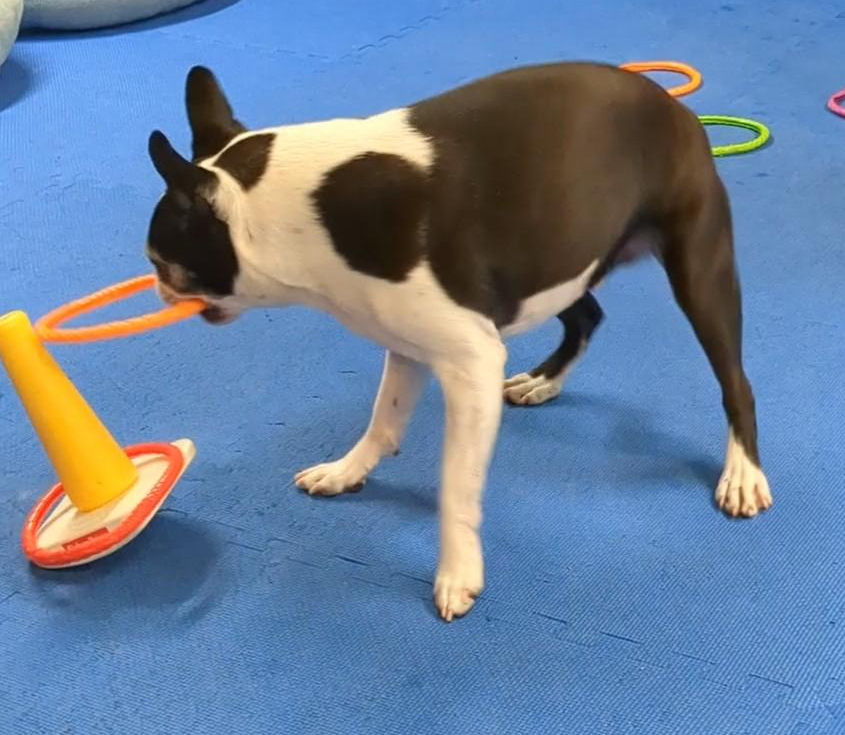One of the tools we use to train dogs is a non-reward marker. It’s a way of telling our dogs they’ve messed up, without saying “No!” or shutting them down. While not all positive reinforcement trainers are on board with using one, we find our dogs do better when they get feedback.
Positive is not permissive. Training a dog with positive reinforcement doesn’t mean the dog gets to do whatever it wants, whenever it wants. It means that while teaching dogs how to behave, you don’t punish them for not doing it. Positive reinforcement has been proven, in study after study, to be more effective long term, and result in more confident, smarter, happier dogs.
If you’re not giving “corrections” or telling your dog “No!,” how do you let them know if they’re wrong? One way is to use a non-reward marker. It lets the dog know they’re not exactly right, and to keep trying to figure things out.
Non-reward marker vs. ignoring
In some training scenarios the ideal response is to ignore the behavior. In others, it’s to let the dog know what they’re doing wrong. How do you know which tool to pull out of your training toolbox?
In cases like barking, or jumping on people, the dog is generally looking for attention. Denying that attention by ignoring the behavior lets the dog know it’s not working. In these situations, the training part comes in as soon as the dog exhibits the behavior you want. Immediately when the dog is quiet, even if it’s for a nanosecond, praise and reward. As soon as the dog has all four feet on the ground, praise and reward. The dog gets what it wants (attention) when we get what we want (quiet, feet on the ground).
Other situations call for other training methods. If you and your dog are playing a training game, like “Put Your Toys Away” or “Ring Stacking,” your dog is going to make “mistakes,” or not get it right. In the early stages of teaching any game, it’s a good idea to keep up an encouraging dialogue, letting your dog know it’s okay to keep trying.
Once the dog knows the game well, you can let them know they messed up with a non-reward marker.
What is a non-reward marker?
You can use any non-threatening phrase as a non-reward marker. Whatever comes naturally to you will work. Just make sure it’s something that doesn’t sound threatening, so no Klingon phrases. Something like “uh-oh!” or “oopsy!” is just about perfect. No one ever sounded angry saying “oopsy!”
Some dogs will know they’re not right because they don’t hear the clicker. Others will need more feedback. Especially dogs who lack confidence may need to hear from you that they’re okay, but just not exactly on target. As long as your dog keeps trying during a session, they’re getting the reinforcement they need.
Having to use a non-reward marker repeatedly may mean the step you’re asking from your dog is too big. Try and think of a way to break down the behavior into smaller pieces. With some games your dog may leap to the end, jumping over many little steps you may have thought were necessary. Other behaviors will be clear as mud to your dog. Observing your dog’s eagerness to play, engagement during the game, and excitement for the “click!” will guide your training. Give your dog the time he needs to understand the game.
Sometimes just wait

Booker, Fran’s 10-year-old Boston Terrier, is a dog who gets a little exuberant and loses focus during training games. He needs the feedback of a non-reward marker to keep him engaged and playing the games we want to play. At some point during particularly movement-oriented games, Booker will get over-excited and forget what he’s supposed to be doing. Even if the game is only 2 Minutes long. The non-reward marker lets him know that he’s still playing the game with us, we’re still paying attention, and “good” behavior will be rewarded.
Torque, Hope’s 8-year-old French Bulldog, listens for the “click!” If he doesn’t hear it, he goes back to see what didn’t happen that was supposed to. Only occasionally does he need to hear a non-reward marker. For him, it’s more of a conversation: “Oh my goodness! What happened?” or “That didn’t work, did it?”
Use it if you need it
You know your dog best. If you think your dog needs the feedback that a non-reward marker will give, use it. See what phrase works best for you and your dog. Be sure it’s not one your dog finds off-putting or that will shut them down. You want your dog to keep trying. And be ready to reward when they get it right.
